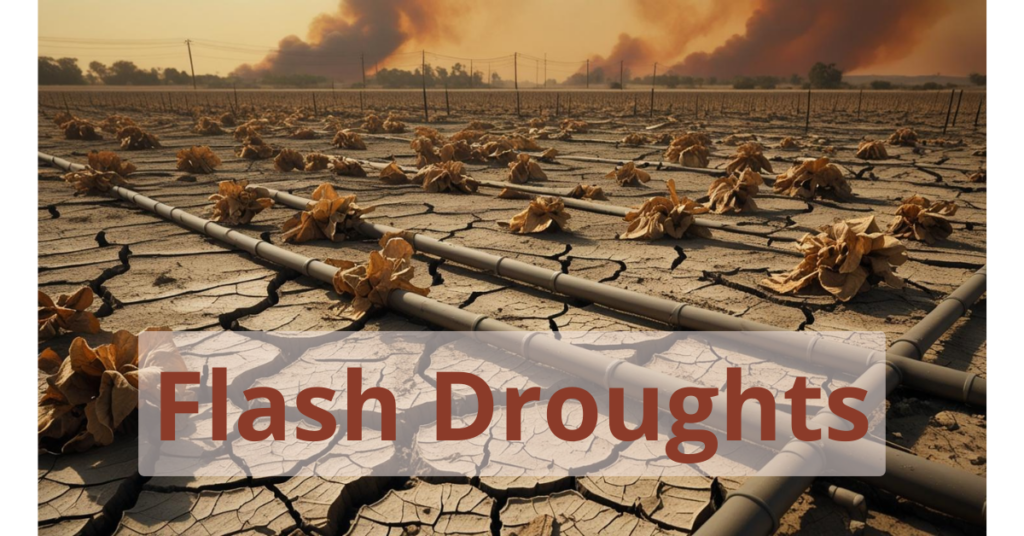
Flash Droughts: The Silent Crisis Accelerating Water Scarcity
When most of us think of droughts, we imagine slow-moving natural disasters—months without rain, reservoirs dropping inch by inch, warning signs building over time. But there’s a new type of drought emerging that defies this narrative. It strikes fast, often without warning, and its impacts can be just as devastating. These are called flash droughts, and according to new research published in Nature Geoscience, they are becoming more frequent, more intense, and more widespread across the globe.
What Is a Flash Drought?
Unlike traditional droughts that develop gradually over seasons, flash droughts can take hold in a matter of days or weeks. Triggered by a sudden lack of rainfall combined with unusually high temperatures and low humidity, these rapid-onset droughts lead to swift declines in soil moisture and plant health. Crops wilt before irrigation systems can compensate. Wildfire risks spike. Water resources—already stretched in many regions—become even more strained.
The recent study by a team of international scientists examined decades of meteorological data to assess the evolution of flash droughts. Their findings were striking: not only are these events becoming more common, but they’re also intensifying faster than before. In some regions, flash droughts now account for up to 40% of all drought occurrences.
“Flash droughts are especially damaging because their rapid development leaves little time for preparation or response,” the authors note.
Why the Surge in Flash Droughts?
The research points to a combination of climate factors. Rising global temperatures—especially heatwaves—accelerate evaporation from soils and plants. When these heat spikes are paired with a break in rainfall, the results can be dramatic. The atmosphere pulls moisture from the land at an unsustainable pace, tipping ecosystems into drought before warning systems can even react.
Regions like the central United States, southern Africa, parts of Europe, and eastern Australia are increasingly vulnerable. Many of these areas are agricultural hubs—making flash droughts a major threat to global food security.
The Human and Environmental Cost
Flash droughts can devastate farms, causing crop failures and livestock losses before mitigation efforts can be mobilized. Municipal water supplies, especially those reliant on surface reservoirs, are also at risk. In urban areas, sudden water restrictions may catch communities off guard. Meanwhile, ecosystems suffer from accelerated stress, with forests and grasslands losing moisture quickly, increasing susceptibility to wildfires.
Perhaps most concerning is the limited window for response. Traditional drought-monitoring systems are not designed to detect such rapid-onset events. By the time official declarations are made, the damage is often already done.
What Can Be Done?
There’s no single solution to the challenge of flash droughts, but awareness is a critical first step. As these events become more common, water planning must evolve to account for both speed and intensity of change. This includes:
- Improved Monitoring and Forecasting: Faster detection tools that integrate soil moisture, temperature, and rainfall anomalies in real-time.
- Resilient Agriculture: Drought-tolerant crops, smarter irrigation systems, and diversified planting strategies.
- Diversifying Water Sources: Relying solely on surface water is increasingly risky. Groundwater reserves—particularly those located deeper and less affected by short-term climate shifts—may offer more stable alternatives.
Rethinking Water Resilience
The rise of flash droughts signals a fundamental shift in how we must think about water scarcity. No longer is drought just a slow-creeping disaster; it can now arrive with speed and severity that catches even experienced planners off guard. For farmers, policymakers, and communities alike, the time to adapt is now.
As we continue to face a warming world, understanding the dynamics of flash droughts will be key to building more resilient systems—both natural and human. Whether through better data, improved planning, or smarter water sourcing, the goal remains the same: to stay one step ahead of the droughts that no longer wait.
A Deeper Look Underground
One of the most overlooked strategies for drought resilience lies beneath our feet. While surface water sources are highly vulnerable to rapid climate shifts, groundwater—especially deeper, untapped reserves—can provide a more stable and sustainable solution during extreme dry periods.
At AquaterreX, we specialize in locating and mapping Deep Seated Water, ancient aquifers that exist well below the shallow groundwater layers most commonly accessed. These deeper sources are often less susceptible to seasonal variability and short-term drought events, making them a vital part of long-term water security planning—particularly in areas prone to flash droughts.
By combining advanced satellite imagery, geological analysis, and proprietary algorithms, AquaterreX helps landowners, municipalities, and agricultural producers identify hidden water sources that can serve as reliable backups when surface systems fail. As flash droughts become more frequent, having access to this deeper safety net could make the difference between vulnerability and resilience.
________________________________________
Sources:
Pendergrass, A. G., et al. (2025). “Widespread intensification of flash droughts over the past two decades.” Nature Geoscience. https://www.nature.com/articles/s41561-025-01719-y
AquaterreX Deep Seated Water Technologies are Unique Exploration and Resource Management Solutions Designed to Solve the World’s Water Challenges https://aquaterrex.com/our-technology/